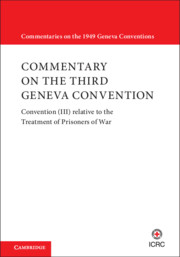 Commentary on the Third Geneva Convention
Commentary on the Third Geneva Convention from Part V - Information Bureaux and Relief Societies for Prisoners of War
Published online by Cambridge University Press: 21 August 2021
Article 122 regulates the establishment and functioning of national informationbureaux. The main task of these bureaux is to manage and process information,including its collection, centralization and transmission, about personsprotected by international humanitarian law who have fallen into enemy hands.Articles 136–139 of the Fourth Convention contain parallel provisions concerningpersons protected under that Convention.
To save this book to your Kindle, first ensure [email protected] is added to your Approved Personal Document E-mail List under your Personal Document Settings on the Manage Your Content and Devices page of your Amazon account. Then enter the ‘name’ part of your Kindle email address below. Find out more about saving to your Kindle.
Note you can select to save to either the @free.kindle.com or @kindle.com variations. ‘@free.kindle.com’ emails are free but can only be saved to your device when it is connected to wi-fi. ‘@kindle.com’ emails can be delivered even when you are not connected to wi-fi, but note that service fees apply.
Find out more about the Kindle Personal Document Service.
To save content items to your account, please confirm that you agree to abide by our usage policies. If this is the first time you use this feature, you will be asked to authorise Cambridge Core to connect with your account. Find out more about saving content to Dropbox.
To save content items to your account, please confirm that you agree to abide by our usage policies. If this is the first time you use this feature, you will be asked to authorise Cambridge Core to connect with your account. Find out more about saving content to Google Drive.